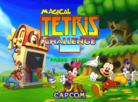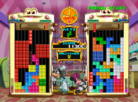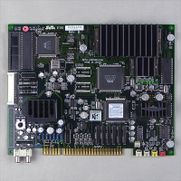Magical Tetris Challenge: Difference between revisions
No need to link to the same article, especially since it's one of the first sections |
|||
| (One intermediate revision by one other user not shown) | |||
| Line 18: | Line 18: | ||
The [[ghost piece]] system was licensed from [[Arika]]. | The [[ghost piece]] system was licensed from [[Arika]]. | ||
== Modes == | |||
=== Magical Tetris === | |||
Magical Tetris is the game's signature mode. In this mode, players have a shared next queue from which each player's next queue draws. Making line clears will send various types of "magical pieces" to the opponent. The magical pieces include pentominoes as well as larger pieces. | |||
Clearing a line while the player has magical pieces in their queue will counter some of their magical pieces, causing to turn into square blocks that are sent back to their opponent. These can be re-countered and grow in size up to a maximum of 5×5. | |||
Magical Tetris can be played in story, versus, or endless mode. | |||
=== Updown Tetris === | |||
Updown Tetris is a two-player game mode which functions as a standard Tetris battle mode with garbage. | |||
Updown Tetris can be played in story or versus mode. | |||
=== Classic Tetris === | |||
Classic Tetris is the game's one-player marathon mode. The player can choose from three difficulties. | |||
== Modes (Game Boy Color) == | |||
The Game Boy Color version has a number of exclusive modes in addition to the ones above, however owing to the Game Boy Color's smaller screen there is only space to fit the player's playfield. For this reason, in Magical Tetris and Updown Tetris the opponent's stack is indicated by a bar at the left showing their stack's height. | |||
=== Quest Mode === | |||
In this mode the player has the goal of collecting coins scattered around the map. Each coin is held by an NPC and must be won by winning a match of Tetris, with the mode depending on the character. The player will have a specific set of numbered coins to collect. | |||
By clearing Quest Mode further modes of Tetris can be unlocked. | |||
=== Signal Tetris === | |||
In Signal Tetris the player has a sample row and a signal row below their playfield, and must change the colours of the signal row to match the sample row. Colours are changed on line clears based on the columns corresponding to the blocks that filled the cleared rows. If the colour is changed to match the sample row then extra rows will be cleared from the bottom of the stack corresponding to the number of matches. | |||
=== Towering Tetris === | |||
In Towering Tetris the player has to downstack through garbage rows that appear at timed intervals. Downstacking will cause the meter on the left to update, and the player wins when they clear the row containing the key block at the bottom. In addition, the player can get a special domino block that can drop single blocks while it is on the screen (similar to Flicky from [[Bloxeed]]). | |||
=== Target Tetris === | |||
Clear all the marked blocks from the screen given a fixed sequence of pieces. A classic puzzle mode. | |||
=== Harmony Tetris === | |||
A cooperative two-player mode. The main gimmick of Harmony Tetris is that when a line is completed it only clears once the other player has completed a line. | |||
== Rotation system == | == Rotation system == | ||
| Line 285: | Line 321: | ||
|} | |} | ||
|} | |} | ||
== Physical scans == | == Physical scans == | ||
| Line 330: | Line 330: | ||
== External Links == | == External Links == | ||
*[https://en.wikipedia.org/wiki/Magical_Tetris_Challenge | *[https://en.wikipedia.org/wiki/Magical_Tetris_Challenge Magical Tetris Challenge on Wikipedia] | ||
*[http://tasvideos.org/GameResources/N64/MagicalTetrisChallenge.html | *[http://tasvideos.org/GameResources/N64/MagicalTetrisChallenge.html Magical Tetris Challenge on TASVideos] | ||
*[http://vgmaps.com/Atlas/GB-GBC/MagicalTetrisChallenge-Quest.png Map of Quest mode] | *[http://vgmaps.com/Atlas/GB-GBC/MagicalTetrisChallenge-Quest.png Map of Quest mode] | ||
Latest revision as of 17:17, 28 February 2023
| Magical Tetris Challenge | |
|---|---|
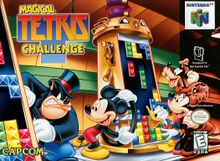 Nintendo 64 North American cover art | |
| Developer(s) | Capcom |
| Publisher(s) |
|
| Platform(s) | Arcade, Game Boy Color, Nintendo 64, PlayStation |
| Release | Arcade
|
| Gameplay info | |
| Next pieces | 2 |
| Playfield size | 10 × 18 |
| Hold piece | No |
| Hard drop | Yes |
| Rotation system | Custom rotation system |
Magical Tetris Challenge is a game released for the Nintendo 64, PlayStation, Game Boy Color, and arcades featuring various Disney characters. In Japan, the Game Boy Color version was titled The Adventure of Tetris with Mickey and Friends.
The ghost piece system was licensed from Arika.
Modes
Magical Tetris
Magical Tetris is the game's signature mode. In this mode, players have a shared next queue from which each player's next queue draws. Making line clears will send various types of "magical pieces" to the opponent. The magical pieces include pentominoes as well as larger pieces.
Clearing a line while the player has magical pieces in their queue will counter some of their magical pieces, causing to turn into square blocks that are sent back to their opponent. These can be re-countered and grow in size up to a maximum of 5×5.
Magical Tetris can be played in story, versus, or endless mode.
Updown Tetris
Updown Tetris is a two-player game mode which functions as a standard Tetris battle mode with garbage.
Updown Tetris can be played in story or versus mode.
Classic Tetris
Classic Tetris is the game's one-player marathon mode. The player can choose from three difficulties.
Modes (Game Boy Color)
The Game Boy Color version has a number of exclusive modes in addition to the ones above, however owing to the Game Boy Color's smaller screen there is only space to fit the player's playfield. For this reason, in Magical Tetris and Updown Tetris the opponent's stack is indicated by a bar at the left showing their stack's height.
Quest Mode
In this mode the player has the goal of collecting coins scattered around the map. Each coin is held by an NPC and must be won by winning a match of Tetris, with the mode depending on the character. The player will have a specific set of numbered coins to collect.
By clearing Quest Mode further modes of Tetris can be unlocked.
Signal Tetris
In Signal Tetris the player has a sample row and a signal row below their playfield, and must change the colours of the signal row to match the sample row. Colours are changed on line clears based on the columns corresponding to the blocks that filled the cleared rows. If the colour is changed to match the sample row then extra rows will be cleared from the bottom of the stack corresponding to the number of matches.
Towering Tetris
In Towering Tetris the player has to downstack through garbage rows that appear at timed intervals. Downstacking will cause the meter on the left to update, and the player wins when they clear the row containing the key block at the bottom. In addition, the player can get a special domino block that can drop single blocks while it is on the screen (similar to Flicky from Bloxeed).
Target Tetris
Clear all the marked blocks from the screen given a fixed sequence of pieces. A classic puzzle mode.
Harmony Tetris
A cooperative two-player mode. The main gimmick of Harmony Tetris is that when a line is completed it only clears once the other player has completed a line.
Rotation system
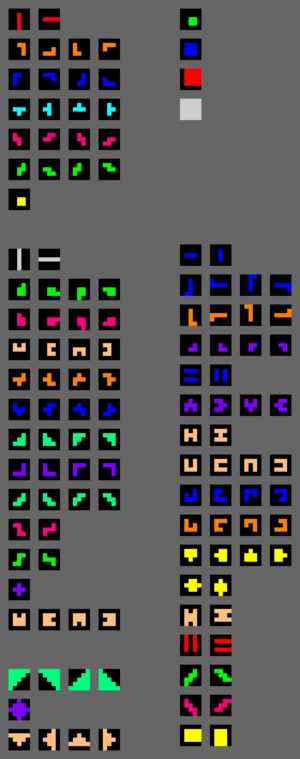
The game uses its own custom rotation system. Unlike most rotation systems with multiple wallkicks like SRS or TGM Rotation, which generally test a list of relative positions and apply the first one where the piece does not collide with the field, this rotation system tries to push the piece depending on where it collided with the field.
Each piece is tied to a 5x5 bounding box, and when the base rotation of the piece fails, the game checks for a solid block and tried to move the piece in a direction according to this table:
|
|
The priority order for the collision checks is Red > Orange > Yellow > Green > Cyan > Blue > Purple. It is not known where the grey cells fit in there, but we know they are higher priority than blue. The black cell in the centre has no direction associated to it.
The first position checked that is both in the rotated piece and in a previously placed block (or out of the playfield bounds) gives the direction of wallkick to try. The piece is pushed one cell in this direction and if it is still colliding with the field, the entire rotation fails. There two known exceptions:
- If the rotated piece collides with the field on both a grey space and the space one cell towards the centre, then the piece ends up being pushed two cells instead.
- If both cyan spaces are colliding with the field and the piece, they cancel out and rotation fails.
Here are some examples:
|
| ||||||||||||
|
| ||||||||||||
|
|
